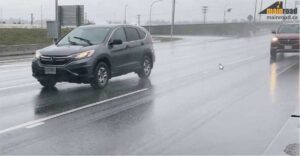Is this your first time, or are you new to, driving in winter?
 Winter conditions can be challenging even for the most experienced of drivers.
Winter conditions can be challenging even for the most experienced of drivers.
Whether this be your first year with a license or your twentieth— the weather can change rapidly, and conditions can become adverse in the blink of an eye. Here are some things to consider before hitting the roads this cold season.
The first thing to consider is how necessary your trip really is. Do you need to go out for a coffee? Could you stay at home and make a pot of coffee yourself? In instances where travel is not necessary, don’t go! The colder months are a great opportunity to spend time inside with loved ones when you don’t have any outside obligations. Weigh your options and see if you need to get into the vehicle at all.
Prep your vehicle with an emergency kit. Include things like food, water, a heavy coat, a flashlight, etc. You never know what may happen on the roads, and it’s better to be safe than sorry.
In bad weather, your speed should decrease. The posted speed limit is based on ideal conditions, and winter conditions are not ideal. Increase your following distance, leaving four seconds between you and the vehicle in front of you.
Tip: Check your following distance by picking a stagnant object like a tree or lamp post that lines up with the car in front of you, then count how many seconds it takes you to reach the object. That will determine your following distance.
 Plan ahead and give yourself extra time to get to your destination. It’s always better to be cautious.
Plan ahead and give yourself extra time to get to your destination. It’s always better to be cautious.
If you’ve never driven in the snow or ice before, it’s important to know that any unexpected movements could cause your vehicle to skid. This is why keeping that extra distance between you and the person ahead of you is crucial. Should you need to brake, you’ll have lots of time to slowly come to a stop.
You may also be used to turning on your head and taillights at dusk, but turning on both your lights when weather is adverse (fog, rain, snow) will allow other cars to see you. Remember that your regular daytime running lights do not activate your taillights. Turn on your taillights. Visibility is key.
Make sure to brush any snow off your vehicle before driving away. Remember, this is not just your windshield but any areas that could restrict your vision. This means side mirrors, door windows, rear windows, etc. Also, try and brush as much snow off of the top of your car as possible. When you start driving, that snow on top may slide down and restrict your vision again. It may also cause disturbances to any vehicles behind you.
Ice on your vehicle should be scraped off all areas that could restrict your vision too. Turn on your car’s defrost, if possible.
 If you find yourself driving in heavy rain, you may encounter hydroplaning. Hydroplaning happens when your tires lose contact with the road and float on a thin layer of water. Ease off the accelerator and keep steering in the direction you want to go. Avoid braking.
If you find yourself driving in heavy rain, you may encounter hydroplaning. Hydroplaning happens when your tires lose contact with the road and float on a thin layer of water. Ease off the accelerator and keep steering in the direction you want to go. Avoid braking.
The same goes for black ice. If you hit ice, focus on smoothly steering where you want to go. Do not brake! It will make the situation worse. Just repeat this maneuver until you regain control.
The important takeaway for driving in winter is that road conditions can be unpredictable. Weather can change quickly, and so can the roads. This winter, the golden rule is this: if you’re not comfortable going out, don’t. Stay home when you can, drive with caution and to the conditions.
 But, with all these tips and tricks under your belt, you’re well on your way to becoming a confident winter driver. Mainroad crews are out helping to make sure that the roads are safe for you, but it’s up to all of us to help them. Never pass a snowplow on the right and give roadside workers space to get their jobs done. Have patience for yourself and other drivers— everyone’s speed should be decreased. Be safe, be cautious, and be prepared before you go out.
But, with all these tips and tricks under your belt, you’re well on your way to becoming a confident winter driver. Mainroad crews are out helping to make sure that the roads are safe for you, but it’s up to all of us to help them. Never pass a snowplow on the right and give roadside workers space to get their jobs done. Have patience for yourself and other drivers— everyone’s speed should be decreased. Be safe, be cautious, and be prepared before you go out.
Let’s all have a safe winter.
Visit ShiftIntoWinter.ca for more tips on winter driving safety.



